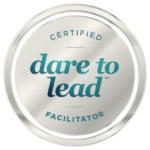
Let me be the first to admit I am a personal “work in progress.” There are moments in my career I am proud of and others I regret. Most of the regrets come from the times I was hurt or angry and tried desperately to avoid feeling those emotions. Yet the emotions always won. They would show up in my body, my stomach aching as I repeatedly played the triggering conversations in my head. I would wind myself up emotionally as I made up stories about what happened (with the ending always in my favor, of course) and tried to believe them.
Once inside that physical and mental trap, my choices were to (1) suck it up, (2) ignore the feelings, or (3) take it out on someone else in unproductive ways. None of those work well.
Calm Is a Leadership Superpower
Definition of “calm”: Creating perspective and mindfulness while managing emotional reactivity.
Calm is contagious and effective leaders model it. It heals anxiety and creates the space we need to become emotionally grounded. Calm leaders practice and grow their emotional knowledge well beyond the three basic emotions most people recognize — mad, sad and glad. Research by Dare to Lead author Brené Brown, Ph.D., found that courageous leaders can recognize and identify up to 40 different emotions.
An emotionally literate leader has the skills to recognize the emotions they’re feeling, name them, and describe their emotional experience. Leaders who don’t cultivate this competency can’t find the right intervention to help them move through the emotion, heal it and change it. They’re also typically not able to recognize difficult emotions in others.
Common Ways We Offload Hurt
Dr. Brown identified six common ways we attempt to offload hurt rather than deal with our emotions.
Bouncing Hurt: Using anger, blame, and/or avoidance when getting too close to emotion.
- Anger: it’s easier to get mad or turn to “I don’t give a damn” than to “I’m hurt.”
- Blame: faultfinding, making excuses, inflicting “payback,” lashing out as self-protection.
- Avoidance: thinking, “I’m fine – no worries,” pretending it doesn’t matter, or saying “whatever.”
Numbing: Taking the edge off emotional pain with ______ (fill in the blank; examples include alcohol, drugs, food, sex, relationships, money, work, the internet, caretaking, gambling … The list goes on).
Stockpiling: I keep firmly packing down the pain. I build up hurt until my body decides that enough is enough. My body shuts me down.
High-Centered: I can’t move forward and I can’t move back. If I recognize my hurt, fear or anger, I’ll be stuck. Once I engage even a little, I won’t be able to move backward and pretend it doesn’t matter. Moving forward might open a floodgate of emotion I can’t control.
Chandeliering: The hurt is packed so far down that it can’t possibly resurface. A seemingly innocent comment sends me into a rage or sparks a crying fit. A small mistake triggers a huge shame attack. Constructive feedback hits a tender place and I jump out of my skin.
Fake Nice: Light and dark are not integrated. I’m overly sweet and accommodating when I feel resentful, hurt, frustrated, etc. I say yes when I mean no. Sometimes my niceness is inauthentic and I can feel like a ticking bomb.
Mindfulness Is a Powerful Tool
Once I have awareness and know I’m avoiding my feelings, I have an alternative and it is an effective tool: successful, calm leaders include mindfulness, curiosity and breathing in their repertoire.
Mindfulness means maintaining a moment-by-moment awareness of our thoughts, feelings, bodily sensations and surrounding environment. When we practice mindfulness, our thoughts tune into what we’re sensing in the present moment. We use our breath to slow down and check our emotional reactions. We ask a lot of questions and stay curious longer to gain more information and data about ourselves. We speak slowly, deliberately and calmly. Anxiety is the most contagious group emotion; fortunately, calm is contagious, too.
Dr. Brown observes, “The research participants who taught me the most about breathing occupy what we would traditionally think of as opposite sides of the professional continuum: yoga teachers, meditation leaders and mindfulness practitioners on one side and soldiers, firefighters, first responders and elite athletes on the other.”
I confess I used to roll my eyes at the word “mindfulness.” Now, I understand what a critical skill it is to practice for calm, successful, daring and courageous leaders.

 After 40 years as president of her print and marketing company, Eileen Rogers’ encore career is now as a leadership coach and business advisor through her company One Creative View. She is a seasoned and accomplished entrepreneur and recognized community leader who is fiercely passionate about supporting and growing more vulnerable and courageous leaders. She is a certified Dare to Lead™ facilitator, Integrative Enneagram practitioner and executive coach.
After 40 years as president of her print and marketing company, Eileen Rogers’ encore career is now as a leadership coach and business advisor through her company One Creative View. She is a seasoned and accomplished entrepreneur and recognized community leader who is fiercely passionate about supporting and growing more vulnerable and courageous leaders. She is a certified Dare to Lead™ facilitator, Integrative Enneagram practitioner and executive coach.
















